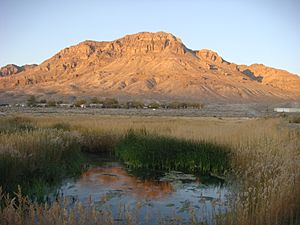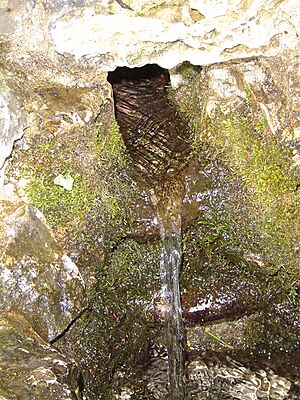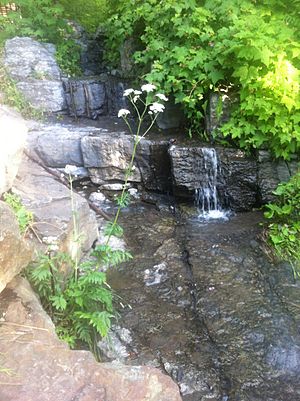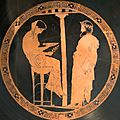Spring (water) facts for kids
A spring is a place where water naturally flows out of the ground. Some springs flow all year long. Others only flow sometimes, like after a lot of rain or when snow melts.
Springs are often the starting points for rivers. The water from a spring flows downhill and forms a stream, which can grow into a river.
Some springs have water that people believe is good for their health. In the past, towns often grew around these springs. People who were sick would visit these places to try and get better. These towns are called spa towns.
How Springs Form

Springs form when water that has soaked into the Earth's surface finds a way to flow back out. This water is called groundwater. It travels through tiny cracks and bigger openings, like caves, underground.
Imagine a giant sponge underground. When it rains, water soaks into this sponge. This water then moves through the ground until it finds an opening. This opening is where the spring appears.
Sometimes, water is pushed to the surface by pressure. This happens when the water source underground is higher than the spring's opening. It's like a hose where water flows out because of the pressure from a higher tank. These are called artesian springs.
Other springs simply flow downhill through the ground. The ground acts like a natural drainpipe, guiding the water to a lower spot where it can exit.
Some springs are heated by activity deep inside the Earth, like near volcanoes. This creates hot springs, where the water comes out warm or even hot!
Over a long time, groundwater can slowly dissolve certain types of rock, like limestone. This process can create huge underground cave systems where the water flows.
Related Topics
Images for kids
-
On an average day nearly 303 million US gallons (1,150,000 m3) of water flow from Big Spring in Missouri at a rate of 469 cubic feet per second (13.3 m3/s).
-
Grand Prismatic Spring, Yellowstone National Park, Wyoming
-
Pruess Lake is spring-fed in the arid Snake Valley of Utah.
-
Fontes Tamarici, in Spain
-
Sokokura, from the series Two Artists Tour the Seven Hot Springs (Sōhitsu shichitō meguri) by Utagawa Toyokuni III and Utagawa Hiroshige, 1854
See also
 In Spanish: Manantial para niños
In Spanish: Manantial para niños














